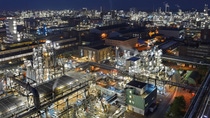Sustainability
Our climate protection goal
We work continuously to further reduce emissions from our production. We have set ourselves ambitious quantitative goals to this end.
On our journey toward climate neutrality, we have set ourselves ambitious goals and are striving worldwide to achieve net zero CO2 emissions1 by 2050. In addition, we want to reduce our greenhouse gas emissions worldwide by 25 percent by 2030 compared with 2018 – and to achieve this despite targeted growth and the construction of a large Verbund site in South China.
Excluding the effects of the planned growth, this means cutting CO2 emissions in half in the current business by the end of this decade. By 2030, we also want to reduce our emissions associated with the goods and services we purchase from our suppliers. BASF aims to reduce its specific Scope 3.1 emissions by 15 percent compared with 2022 across the portfolio.
In 2018, BASF Group’s worldwide emissions amounted to 21.9 million metric tons of CO2 equivalents. In 1990, this figure was roughly twice as high. The 2030 emissions goal represents a reduction of approximately 60 percent compared to 1990 levels, which exceeds the European Union’s target of minus 55 percent.
Find more information on the BASF Group’s emissions here.
At the heart of the long-term transition toward net zero CO2 emissions by 2050 is the use of new technologies, which will replace fossil fuels such as natural gas with electricity from renewable sources. Most of these technologies are being pioneered by BASF in collaboration with partners and are currently in a pilot stage. Broad scaleup of these technologies will only be fully realizable after 2030. In order to accelerate the avoidance of CO2 emissions prior to that date, BASF also continues to systematically implement continuous improvement processes for existing production plants. In addition, BASF will progressively switch to renewable sources to meet its electricity needs and intends to invest in wind parks to facilitate this.
We have bundled these measures in our global Carbon Management.
Our Carbon Management and further compensation measures
In addition, we will also consider temporarily taking external offsetting measures such as purchasing certificates if the technical or economic environment does not permit a stabilization of emissions at the 2018 level using the above approaches. Sharp increases due to the startup of large-scale plants will be progressively offset. When deciding on investments and acquisitions, we systematically consider the effects on greenhouse gas emissions.
1 The goal includes Scope 1, Scope 2 and Scope 3.1 emissions. Other greenhouse gases are converted into CO2 equivalents according to the Greenhouse Gas Protocol.
More information about our climate protection goal:


